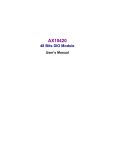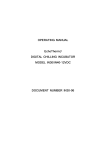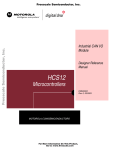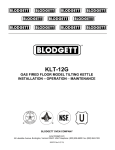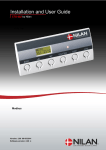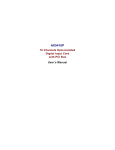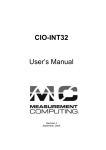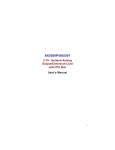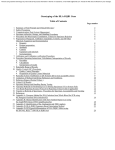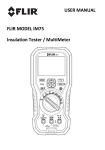Download Introduction
Transcript
AX5240 32 Bit DI with Interrupt, 40 Bit DIO or 6 Channel Counter/Timer Board User’s Manual Disclaimers The information in this manual has been carefully checked and is believed to be accurate. AXIOMTEK Co., Ltd. assumes no responsibility for any infringements of patents or other rights of third parties which may result from its use. AXIOMTEK assumes no responsibility for any inaccuracies that may be contained in this document. AXIOMTEK makes no commitment to update or to keep current the information contained in this manual. AXIOMTEK reserves the right to make improvements to this document and/or product at any time and without notice. No part of this document may be reproduced, stored in a retrieval system, or transmitted, in any form or by any means, electronic, mechanical, photocopying, recording, or otherwise, without the prior written permission of AXIOMTEK Co., Ltd. Copyright 1997 by AXIOMTEK Co., Ltd. All rights reserved. December, 1997, Ver. A2 Printed in Taiwan Trademarks Acknowledgments AXIOMTEK is a trademark of AXIOMTEK Co., Ltd. IBM is a registered trademark of International Business Machines Corporation. MS-DOS, Microsoft C and QuickBasic are trademarks of Microsoft Corporation. TURBO C is a trademark of Borland Inc. BASIC is a trademark of Dartmouth College. Intel is a trademark of Intel Corporation. Other brand names and trademarks are the properties and registered brands of their respective owners. ESD Precautions Integrated circuits on computer boards are sensitive to static electricity. To avoid damaging chips from electrostatic discharge, observe the following precautions: Do not remove boards or integrated circuits from their anti-static packaging until you are ready to install them. Before handling a board or integrated circuit, touch an unpainted portion of the system unit chassis for a few seconds. This helps to discharge any static electricity on your body. Wear a wrist grounding strap, available from most electronic component stores, when handling boards and components. Unpacking The AX5240 is packed in an anti-static bag. This board has components that are easily damaged by static electricity. Do not remove the anti-static wrapping until proper precautions have been taken. Safety instructions in front of this User’s Manual describe anti-static precautions and procedures. Inventory and Inspection After unpacking the board, place it on a raised surface and carefully inspect the board for any damage that might have occurred during shipment. Ground the board and exercise extreme care to prevent damage to the board from static electricity. Integrated circuits will sometimes come out of their sockets during shipment. Examine all integrated circuits, particularly the BIOS, processor and keyboard controller chip to ensure that they are firmly seated. The AX5240 32 Bit DI with Interrupt, 40 Bit DIO or 6 Channel Counter/Timer Board package includes the following: ! AX5240 Board ! AS59099 DAC Driver CD ! AX5240 Technical Manual ! AX5240 User‘s Manual ! Warranty Card Make sure that all of the items listed above are present. What To Do If There Is A Problem If there are damaged or missing parts, contact your supplier and/or dealer immediately. Do not attempt to apply power to the board if there is damage to any of its components. Table of Contents C h a p t e r 1 Introduction .................................................................................. 1 General Description............................................................................................................................ 1 Features .............................................................................................................................................. 1 Specifications ..................................................................................................................................... 2 Accessories Guide .............................................................................................................................. 2 C h a p t e r 2 Board Configuration and Installation .................................... 3 Component Locator Diagram ............................................................................................................. 3 Base Address Switch .......................................................................................................................... 4 +12V or Ground Selection ................................................................................................................. 5 External Interrupt Enable, Clock and Interrupt Output Setting.......................................................... 6 Independent/Chained Interrupt Selection ........................................................................................... 7 Interrupt Source Selection .................................................................................................................. 8 Interrupt Level Selection .................................................................................................................... 9 Connector Pin Assignment............................................................................................................... 10 Pull High/Down Resistors................................................................................................................ 13 Board Installation ............................................................................................................................. 14 C h a p t e r 3 Register Format and Description .......................................... 15 AX5240 I/O Address Map ............................................................................................................... 15 C h a p t e r 4 Programming .............................................................................. 16 Appendix A PC I/O Port Mapping.................................................................... 17 Appendix B Summary of Interrupt Levels .................................................... 18 Appendix C Block Diagram ............................................................................... 19 Appendix D Technical Reference .................................................................... 20 Digital Input and Output................................................................................................................... 20 AX5240 32 Bit DI with Interrupt, 40 Bit DIO or 6 Channel Counter/Timer Board User’s Manual Chapter 1 Introduction General Description The AX5240 is a digital with/without interrupt or timing I/O board for IBM PC/XT/AT and compatible computers. The board uses a pair of the powerful Zilog Z8536 programmable digital I/O chips which make it programmable for 32-bit digital input with interrupt, 40-bit digital I/O or 6-channel counter/timer board. The Z8536 may be programmed as 20 lines of digital I/O. Each line may be independently set for input or output and may be inverting or non-inverting. Once the digital I/O lines are programmed, writes and reads are on a byte wide basis to the three addresses for ports A, B and C. The digital I/O ports may also be programmed as a two-wire or three-wire handshaking interface port. Up to three down counters may be set up independently or chained together internally. Each has an input, an output, a gate and a trigger. The trigger may be used externally or internally via software to load the count value from the hold register into the counter and initiate the count down. Outputs may be square wave, one shot or pulse at terminal count; all three modes are recyclable. Inputs are programmable for level or edge trigger, either high, low, rising or falling. Outputs may be inverting or non-inverting. Each Z8536 may be programmed to accept 16 independent external interrupts, high, low, rising or falling edge, and output an interrupt to the PC. The output from the two Z8536s may be ANDed by onboard jumper so that any of 32 external events may cause a PC interrupt service routine to be executed. All AX5240's I/O lines are built in a 50-pin connector. To ease and guide user in application, many programming examples on a diskette is included along with the AX5240 board. About more detailed information for programming the Z8536, user must refer to Zilog Z8536 manual. Features ! Fully programmable for combinations of up to # 32 vector interrupt director # 40 bits of bit setable digital I/O # Six 16-bit counters with In, Out, Gate and Trigger ! ! ! ! ! Pattern matching Inverting or non-inverting input and output Rising or falling edge or high or low level trigger/sense Two-wire or three-wire handshaking digital interface Programming examples included Introduction 1 AX5240 32 Bit DI with Interrupt, 40 Bit DIO or 6 Channel Counter/Timer Board User’s Manual Specifications ! Digital I/O # Z8536 Output High : 2.4V min. @ -250µA # Z8536 Output Low : 0.5V max. @ 3.2mA # Z8536 Input High : 2.0V min., 7.3V max. # Z8536 Input Low : -0.3V min., 0.8V max. # Z8536 Drive Capability : 5 LSTTL loads ! Interrupt Input # Type : Positive edge triggered # PC Bus IRQ : IRQ 2, 3, 4, 5, 6, 7 # Enable Interrupt : TTL "0" # External Interrupt : TTL positive trigger ! Power Requirement # +5VDC : 440mA typ. 720mA max. ! Physical/Environment # Dimensions : 98mm X 104mm # Weight : 110g # Operating Temperature Range : 0ΕC to +55ΕC # Storage Temperature Range : -20ΕC to +70ΕC # Relative Humidity : 0 to 90%, non-condensing Accessories Guide ! AX754 24-channel opto-isolated D/I panel for signal connection and conditioning with the AX5240. Shipped with 3.3 feet (1 meter) cable and 50-pin connector. If used only 20 channels are available and if using interrupt ability only 16 channels are permitted. ! AX755 8-channel electromechanical single-pole, double-throw(SPDT) and 16-channel optoisolated digital I/P panel. Shipped with 3.3 feet (1 meter) cable and 50-pin connector. If used only 16 channels are available and permitted to interrupt only 4 channels of relay can be used. ! AX756 24-channel electromechanical single-pole, double-throw (SPDT) which can be driven by the AX5240. Shipped with 3.3 feet (1 meter) cable and 50-pin connector. If used only 20 channels are available. 2 Introduction AX5240 32 Bit DI with Interrupt, 40 Bit DIO or 6 Channel Counter/Timer Board User’s Manual Chapter 2 Board Configuration and Installation Component Locator Diagram The following figure shows the component location of AX5240. All switch and jumper settings in this figure are the factory default settings. RP2 1 V G 1 JP1 V SECOND Z8536 CN1 2 RP1 1 G JP2 CN2 1 U3 1 RP3 1 1 2 RP4 1 RP6 FIRST Z8536 U4 RP5 1 JP7 JP4 JP3 JP6 1 JP9 JP8 JP11 JP5 JP10 O1 2 3 4 5 6 7 8 N X3 2 1 0 SW1 JP12 1 49 50 49 JP13 50 1 X7 6 5 4 3 2 Board Configuration and Installation 3 AX5240 32 Bit DI with Interrupt, 40 Bit DIO or 6 Channel Counter/Timer Board User’s Manual Base Address Switch The AX5240 board occupies 8 consecutive locations in I/O address space. The first address or base address is selected via a 8-position DIP switch labeled SW1. If more than one boards are to be installed to one PC, each board must be given its own distinct I/O address or base address. No more than one board may use the same base address. When you are selecting the base address, it would be better if you check with Appendix A to avoid conflicting with other installed devices. In factory, the AX5240 base address is set for 300 Hex or 768 Dec. To set to appropriate base address, switch the individual switches into the ON or OFF position. The following figure shows SW1 default setting, 300 Hex, where switches 1 and 2 are moved to the OFF position while leaving all other switches in the ON position. A table for the switch configuration is given in the following page. ! Base Address Switch Setting SW1 O N 8 9 1 2 7 3 6 4 5 5 4 6 3 7 X 8 ON = 0 OFF = 1 WEIGHTING 8 Dec (008 Hex) 16 Dec (010 Hex) 32 Dec (020 Hex) 64 Dec (040 Hex) 128 Dec (080 Hex) 256 Dec (100 Hex) 512 Dec (200 Hex) Each switch represents one address weight. The desired base address is determined by adding the weight of the switches flipped at OFF position. The base address calculation is as follows: Base Address = 512 + 256 = 768 Dec = 300 Hex 4 Board Configuration and Installation AX5240 32 Bit DI with Interrupt, 40 Bit DIO or 6 Channel Counter/Timer Board User’s Manual I/O Port Range (Hexadecimal) DIP Switch Position 1 A9 2 A8 3 A7 4 A6 5 A5 6 A4 7 A3 8 A2 200 ! 207 1 0 0 0 0 0 0 X 208 ! 20F 1 0 0 0 0 0 1 X 210 ! 217 1 0 0 0 0 1 0 X 218 ! 21F 1 0 0 0 0 1 1 X 220 ! 227 3F7 1 . . 1 . . 1 0 . . 1 . . 1 0 . . 0 . . 1 0 . . 0 . . 1 1 . . 0 . . 1 0 . . 0 . . 1 0 . . 0 . . 0 X . . X . . X 3FF 1 1 1 1 1 1 1 X 300 3F0 3F8 . . ! . . ! ! NOTE 307 (*) 0 = ON, 1 = OFF, X = Don't care (*) : Factory default setting +12V or Ground Selection Pins 2 and 4 at CN1 and CN2 50-pin connectors can be connected to +12V PC power or Ground by setting JP1 and JP2 jumpers, respectively. When the +12V is jumpered to the CN1 or CN2 connector, you may use the AX5240 for direct relay driving or input pull high voltage. The JP1 and JP2 jumper settings are listed in below table. Jumper Configuration Description V G Connect PC Ground to pins 2 and 4 of CN1 connector. This is also JP1 factory default setting. (*) V G Connect +12VDC PC power to pins 2 and 4 of CN1 connector. (**) V G Connect PC Ground to pins 2 and 4 of CN2 connector. This is also JP2 factory default setting. (*) V G Connect +12VDC PC power to pins 2 and 4 of CN2 connector. (**) JP1 JP1 JP2 JP2 Board Configuration and Installation 5 AX5240 32 Bit DI with Interrupt, 40 Bit DIO or 6 Channel Counter/Timer Board User’s Manual NOTE (*) : Through the corresponding connector, the AX5240 is compatible with AX1416 and AX1424 solid-state module panels from AXIOMTEK. (**) : Through the corresponding connector, the AX5240 is compatible with AX754, AX755 and AX756 accessory boards from AXIOMTEK. When the AX5240 is used with standard Opto-22 interface panel board, pins 2 and 3 of JP1/JP2 must be connected. External Interrupt Enable, Clock and Interrupt Output Setting JP3 through JP6 jumpers are used to set external interrupt input, second Z8536 interrupt output, 2.5MHz and 5MHz clock output for CN1 connector. The JP3 through JP6 jumper configurations are listed in the following table. Jumper Configuration Description Connect the external interrupt input signal at pin 15 of CN1 connector to internal interrupt ckt. If external interrupt source is selected (refer to Interrupt Source Selection section), this JP3 jumper must be connected. JP3 JP4 Connect second Z8536 interrupt output to pin 13 of CN1 connector. JP5 Connect the 2.5MHz clock output to pin 11 of CN1 connector. JP6 Connect the 5MHz clock output to pin 9 of CN1 connector. In factory, all JP3 through JP6 jumpers are left open. 6 Board Configuration and Installation AX5240 32 Bit DI with Interrupt, 40 Bit DIO or 6 Channel Counter/Timer Board User’s Manual JP8 through JP11 jumpers are used to set external interrupt enable signal, first Z8536 interrupt output, 2.5MHz and 5MHz clock output for CN2 connector. The JP8 through JP11 jumper configurations are listed in the following table. Jumper Configuration Description Connect the external interrupt enable signal at pin 15 of CN2 connector to internal interrupt ckt. If external interrupt source is selected (refer to Interrupt Source Selection section), this JP8 jumper must be connected. JP8 JP9 Connect first Z8536 interrupt output to pin 13 of CN2 connector. JP10 Connect the 2.5MHz clock output to pin 11 of CN2 connector. JP11 Connect the 5MHz clock output to pin 9 of CN2 connector. In factory, all JP8 through JP11 jumpers are left open. Independent/Chained Interrupt Selection Interrupts for the two Z8536s may be independent or chained together by setting JP7 jumper. Each Z8536 may be programmed to accept 16 independent external interrupt lines in high, low, rising or falling edge, and output an interrupt to PC interrupt service routine. Or the 16 interrupt lines may be chained together as a set of 32 external interrupt lines by connecting pins 2 and 3 of JP7 jumper. Jumper Configuration JP7 JP7 Board Configuration and Installation Description Interrupts for the two Z8536s are independent, that is each Z8536 accepts 16 independent external interrupt lines. Interrupts are chained from first to second Z8536 as a set of 32 external interrupt lines. This is also JP7 factory default setting. 7 AX5240 32 Bit DI with Interrupt, 40 Bit DIO or 6 Channel Counter/Timer Board User’s Manual Interrupt Source Selection By configuring JP12 jumper, you may have several choices of interrupt source for your PC. The following table lists all the possibly configurations of JP12. Jumper Configuration Description X3 2 1 0 Select interrupt source from both Z8536 chips. When first and second Z8536 chips are chained, JP12 must be jumpered in position 0. X3 2 1 0 Select interrupt output from first Z8536 chip. X3 2 1 0 Select interrupt output from second Z8536 chip. JP12 JP12 JP12 X3 2 1 0 Select external interrupt source. (*) JP12 X3 2 1 0 Disable interrupt. This is JP12 factory default setting. JP12 (*) : When external interrupt source is selected: ♦ JP3 and JP8 must be installed. ♦ The external interrupt signal routed to the PC bus is determined by EX INT pin at CN1 and EX INTE pin at CN2. NOTE EX INTE EX INT Description 0 0 0→1 1→0 1 X External Interrupt disable 1 X External Interrupt disable An interrupt generated No interrupt generated X : don't care 8 Board Configuration and Installation AX5240 32 Bit DI with Interrupt, 40 Bit DIO or 6 Channel Counter/Timer Board User’s Manual Interrupt Level Selection The AX5240 provides interrupt handling capability for various applications. The signal from interrupt source can be led to any of the six PC interrupt request lines (IRQ level 2-7) by setting JP13 jumper. Refer to the following table and properly set JP13 if the AX5240 board uses interrupt. Jumper Configuration Description JP13 Select IRQ 2. X7 6 5 4 3 2 JP13 Select IRQ 3. X7 6 5 4 3 2 JP13 Select IRQ 4. X7 6 5 4 3 2 JP13 Select IRQ 5. X7 6 5 4 3 2 JP13 Select IRQ 6. X7 6 5 4 3 2 JP13 Select IRQ 7. X7 6 5 4 3 2 JP13 X7 6 5 4 3 2 NOTE If no interrupt is used, jumper the JP13 in position X. This is also JP13 factory default setting. It cannot be stated often enough to those unfamiliar with the Z8536. WHENEVER THE Z8536 IS POWERED ON OR RESET, ALL PINS ARE SET TO HIGH IMPEDANCE INPUT. Board Configuration and Installation 9 AX5240 32 Bit DI with Interrupt, 40 Bit DIO or 6 Channel Counter/Timer Board User’s Manual The implications of this fact is that if you have output devices such as solid state relays, they may be switched on whenever the computer is powered on or reset. To prevent unwanted switching and to drive all outputs to a known state after power on or reset, pull all pins either high or low through a 10K ohm resistor. Connector Pin Assignment All AX5240's input and output signals are built in two standard 50-pin male mating connectors labeled CN1 and CN2. First Z8536 chip is brought to CN2 (accessible from the rear panel of the PC), while second Z8536 is brought to CN1. The connectors provides easy and direct cabling connections between the AX5240 and AXIOMTEK's accessory boards such as AX754, AX755 and AX756. The CN1 and CN2 pin assignments and description are given as follows: 10 Board Configuration and Installation AX5240 32 Bit DI with Interrupt, 40 Bit DIO or 6 Channel Counter/Timer Board User’s Manual CN1 PC0 PC1 PC2 PC3 5 MHz 2.5 MHz INT OUT EX INT PB0 PB1 PB2 PB3 PB4 PB5 PB6 PB7 PA0 PA1 PA2 PA3 PA4 PA5 PA6 PA7 +5V 1 3 5 7 9 11 13 15 17 19 21 23 25 27 29 31 33 35 37 39 41 43 45 47 49 2 4 6 8 10 12 14 16 18 20 22 24 26 28 30 32 34 36 38 40 42 44 46 48 50 OPT1 OPT2 GND GND GND GND GND GND GND GND GND GND GND GND GND GND GND GND GND GND GND GND GND GND GND CN1 connector pin assignments: Pin Name Description PC0~PC3 Second Z8536's Port C four digital I/O lines. 5MHz When JP6 jumper is installed, this pin is connected to 5MHz clock output. 2.5MHz When JP5 jumper is installed, this pin is connected to 2.5MHz clock output. INT OUT When JP4 jumper is installed, this pin is connected to second Z8536 interrupt output. EX INT This is the external interrupt input pin. PB0~PB7 Second Z8536's Port B eight digital I/O lines. PA0~PA7 Second Z8536's Port A eight digital I/O lines. +5V +5VDC PC power. OPT1, OPT2 By setting JP1 jumper (refer to +12V or Ground Selection section), these pins can be connected to +12V PC power or Ground. GND Ground. Board Configuration and Installation 11 AX5240 32 Bit DI with Interrupt, 40 Bit DIO or 6 Channel Counter/Timer Board User’s Manual CN2 PC0 PC1 PC2 PC3 5 MHz 2.5 MHz INT OUT EX INTE PB0 PB1 PB2 PB3 PB4 PB5 PB6 PB7 PA0 PA1 PA2 PA3 PA4 PA5 PA6 PA7 +5V 1 3 5 7 9 11 13 15 17 19 21 23 25 27 29 31 33 35 37 39 41 43 45 47 49 2 4 6 8 10 12 14 16 18 20 22 24 26 28 30 32 34 36 38 40 42 44 46 48 50 OPT1 OPT2 GND GND GND GND GND GND GND GND GND GND GND GND GND GND GND GND GND GND GND GND GND GND GND CN2 connector pin assignments: Pin Name Description PC0~PC3 First Z8536's Port C four digital I/O lines. 5MHz When JP11 jumper is installed, this pin is connected to 5MHz clock output. 2.5MHz When JP10 jumper is installed, this pin is connected to 2.5MHz clock output. INT OUT When JP9 jumper is installed, this pin is connected to first Z8536 interrupt output. EX INTE This is the external interrupt enable pin. PB0~PB7 First Z8536's Port B eight digital I/O lines. PA0~PA7 First Z8536's Port A eight digital I/O lines. +5V +5VDC PC power. OPT1, OPT2 By setting JP2 jumper (refer to +12V or Ground Selection section), these pins can be connected to +12V PC power or Ground. GND 12 Ground. Board Configuration and Installation AX5240 32 Bit DI with Interrupt, 40 Bit DIO or 6 Channel Counter/Timer Board User’s Manual Pull High/Down Resistors On the AX5240 board, there are reserved spaces for installing pull high/down resistors (resistor packs). Below table lists the DI/O lines and their corresponding resistor packs. DI/O Lines Resistor Rack First Z8536 PA0~PA7 PB0~PB7 PC0~PC3 Second Z8536 PA0~PA7 PB0~PB7 PC0~PC3 RP4 RP5 RP6 RP2 RP3 RP1 When using interrupt, the resistor packs have to be installed to avoid unstable floating signals. The resistor values are suggested to be within 4.7KΩ~10KΩ and pull high. The positions of resistor pack (RP1~RP6) are shown on location diagram. The pin definitions are illustrated as follows: 1 2 3 4 ↑ PC VCC 5 6 Bit 0 – Bit 7 7 8 9 10 ↑ PC Ground The RP1~RP6 are all the same as above figure. Board Configuration and Installation 13 AX5240 32 Bit DI with Interrupt, 40 Bit DIO or 6 Channel Counter/Timer Board User’s Manual Board Installation The AX5240 board is shipped with protective electrostatic cover. When unpacking, touch the board electrostatically shielded packaging with the metal frame of your computer to discharge the accumulated static electricity prior to touching the board. The following description summarizes the procedures for installing AX5240: WARNING TURN OFF the PC and all accessories connected to the PC whenever installing or removing any peripheral board including the AX5240 series board. Installation Procedure: 1. Turn off the PC and all accessories power. 2. Unplug all power cords and entire cables from PC's rear panel. 3. Remove the PC's cover (see your PC operation Guide if you are not skillful about it). 4. Find an unused expansion slot. Remove the blank expansion slot cover and save the screw for affixing retaining bracket. 5. Grab the upper edge of the AX5240 board. Align the AX5240 board's retaining bracket with the expansion slot rear panel, and straighten the board's gold finger with the expansion slot, crush the board into the slot. 6. Restore the screw to the expansion slot retaining bracket. 7. Replace the PC's cover and connect the cables you detached in step 2. 8. Turn on the PC and other peripheral devices power. 14 Board Configuration and Installation AX5240 32 Bit DI with Interrupt, 40 Bit DIO or 6 Channel Counter/Timer Board User’s Manual Chapter 3 Register Format and Description The AX5240 occupies 8 consecutive addresses of PC I/O address space. The first address or base address is determined during installation by setting onboard DIP switch labeled SW1. The base address +0 through +3 access first Z8536's three data and one control registers. The base address +4 through +7 access second Z8536's three data and one control registers. This chapter lists each AX5240 register in terms of address and function. Each register is easy to read and write to by using direct I/O instructions of whatever application languages. To write a control word or data to the 8-bit wide register, the individual bits must be set to 0 or 1 then combined to form a byte. An 8-bit data is read from the register and the individual bits are analyzed to determine which bits are 0 or 1. AX5240 I/O Address Map The registers and their functions are listed in the following table (R = Read, W = Write, Base = Base address). Address First Z8536 Base +0 Base +1 Base +2 Base +3 Function Type Port C digital input/output Port B digital input/output Port A digital input/output Control and status register R/W R/W R/W R/W Second Z8536 Base +4 Port C digital input/output Base +5 Port B digital input/output Base +6 Port A digital input/output Base +7 Control and status register R/W R/W R/W R/W More detailed information can be found in Zilog Z8536 manual. Register Format and Description 15 AX5240 32 Bit DI with Interrupt, 40 Bit DIO or 6 Channel Counter/Timer Board User’s Manual Chapter 4 Programming The diskette supplied contains many demo programs, in different kinds of programming language, listed in the following description. The main spirit of AX5240 lies on the programming of Z8536 which is given in more detailed at the technical manual of Z8536. ! Microsoft Quick Basic USERVENT.ASM Assembly part of ONUEVENT.BAS. Its major task is to do interrupt service routine. ONUEVENT.BAS Demo how to invoke interrupt process routine. ! Microsoft C 6.00 DEMO_DIO.C Demo how to issue digital output and digital input. DEMO1INT.C Demo how to detect interrupt from Port A (8 bits) at CN2 connector. DEMO2INT.C Demo how to detect interrupt from Port A (8 bits) at CN1 connector. INT16BIT.C Demo how to detect interrupt from Port A and Port B at CN2. INT32A.C Demo how to detect interrupt from both Port A and Port B at CN1 and CN2. INT32B.C The same as INT32A.C but in different structure. ! BASIC Language DIGITIN.BAS Demo how to read digital input. DIGITOUT.BAS Demo how to write digital output. COUNTER.BAS Demo how to program the counter. MATCHP.BAS Demo how to detect a matched pattern. ! TC For Turbo C users, you have to modify the MSC demo programs. ! Turbo Pascal Users have to migrate to Pascal programs by the same I/O read and write sequence which apply to the MSC demo program. 16 Programming AX5240 32 Bit DI with Interrupt, 40 Bit DIO or 6 Channel Counter/Timer Board User’s Manual Appendix A PC I/O Port Mapping I/O Port Address Range Function 000 ! 1FF PC reserved 200 ! 20F Game controller (Joystick) 278 ! 27F Second parallel printer port (LPT2) 2E1 GPIB controller 2F8 ! 2FF Second serial port (COM2) 320 ! 32F Fixed disk (XT) 378 ! 37F Primary parallel printer port (LPT1) 380 ! 38F SDLC communication port 3B0 ! 3BF Monochrome adapter/printer 3C0 ! 3CF EGA, reserved 3D0 ! 3DF Color/graphics adapter 3F0 ! 3F7 Floppy disk controller 3F8 ! 3FF Primary serial port (COM1) PC I/O Port Mapping 17 AX5240 32 Bit DI with Interrupt, 40 Bit DIO or 6 Channel Counter/Timer Board User’s Manual Appendix B Summary of Interrupt Levels Interrupt Level 18 Usage NMI Parity, AT Channel Check IRQ0 Interval Timer 1, Counter 0 Out IRQ1 Keyboard Controller IRQ2 Reserved (XT) Cascade Interrupts from IRQ8 to IRQ15 (AT) IRQ3 Serial Port #2 IRQ4 Serial Port #1 IRQ5 Hard Disk (XT) Parallel Port #2 (AT) IRQ6 Floppy Disk IRQ7 Parallel Port #1 IRQ8 Real Time Clock (AT) IRQ9 Re-directed to IRQ2 (AT) IRQ10 Unassigned IRQ11 Unassigned IRQ12 Unassigned IRQ13 Coprocessor Error IRQ14 Hard Disk IRQ15 Unassigned Summary of Interrupt Levels AX5240 32 Bit DI with Interrupt, 40 Bit DIO or 6 Channel Counter/Timer Board User’s Manual Appendix C Block Diagram +5V IRQ2IRQ7 IRQ CKT. 2 I B M P C B U S A1, A0 D0-D7 IEI DECODE CKT PA(8) PB(8) 1st 8536 IEO PC(4) 1 INT A1, A0 D0-D7 Block Diagram INT 2nd 8536 IEI PA(8) PB(8) PC(4) C 5O 0N | N E PC I T NO R C 5O 0N | N E PC I T NO R 19 AX5240 32 Bit DI with Interrupt, 40 Bit DIO or 6 Channel Counter/Timer Board User’s Manual Appendix D Technical Reference Digital Input and Output Digital signals are used for detecting logical status or controlling devices. TTL level signals are usually developed by most DAS systems. Some application are given as follows: ! TTL or LSTTL Level I/O Connections TTL Level I/O Connection TTL Devices DO DI DGND Connection with CMOS Device ─ Use a pull-up resistor if you wish to interface to CMOS devices. This will raise the logic high output level from its minimum TTL level of 2.4V to +5V suitable for CMOS interface. VCC PULL-UP RESISTOR TTL 20 CMOS Technical Reference AX5240 32 Bit DI with Interrupt, 40 Bit DIO or 6 Channel Counter/Timer Board User’s Manual Digital Input for Open/Short Switch Detection ─ A pull-up resistor must be connected, especially at long distance wiring, to ensure logic high input level. +5V * 4.7K SS DI Switch SS ! Digital Input for Large Signal DI R Digital Output for Relay Driving - The D1 diode is added to protect the IC driver against the inductive "kickback" from the relay coil. VCC D1 DO Technical Reference 21

























